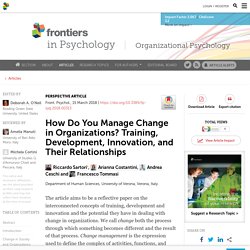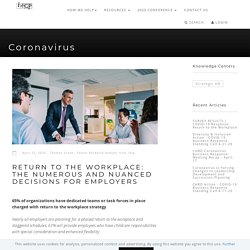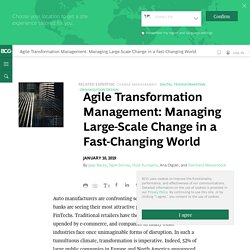

How Do You Manage Change in Organizations? Training, Development, Innovation, and Their Relationships. Introduction The focus of the article is organizational innovation as a way by which companies, businesses, firms and enterprises, in one word organizations, manage change in the multidimensional perspective of survival, competitiveness, growth, and development (Sartori et al., 2013, 2017a; Sartori and Scalco, 2014; Ceschi et al., 2017b).

In its narrowest meaning, organizational innovation is the process of transforming ideas or inventions into goods or services that generate value and for which customers will pay. This is the case, for example, when a new personality test is developed in order to meet the new selection and assessment demands of an organization (Cubico et al., 2010; Ceschi et al., 2014c; Sartori et al., 2014, 2016a; Charkhabi et al., 2016). More widely, organizational innovation means the application of new and useful methods in undertaking practices of business, the organization of workplace or external relationships. Change in Society and Organizations 1. 2. 3. 4. 5. Driving organizational and behavior changes during a pandemic.
August 6, 2020In our previous post, we provided an overview of what companies are doing during the COVID pandemic to stabilize or even improve their organizational health.

But one question remains: what can be done to drive these kinds of organization-wide behavior changes during a time of unprecedented change and a shift to remote working? On building change capability. The Accidental Change Agent: A Fresh Take on Organizational Change (June 2020) by Erik S. Meyers. Return to the Workplace: The Numerous and Nuanced Decisions for Employers. 65% of organizations have dedicated teams or task forces in place charged with return to the workplace strategy Nearly all employers are planning for a phased return to the workplace and staggered schedules; 63% will provide employees who have childcare responsibilities with special consideration and enhanced flexibility.

L'après-confinement en entreprise : une experte nous raconte. La crise du coronavirus a mis tout un pan de la société à l’arrêt.

Mais alors que la date du début du déconfinement a été fixée au 11 mai prochain, peut-on imaginer reprendre sereinement le travail comme avant ? Psychologue clinicienne à la Sorbonne Université et spécialiste du retour au travail des patients atteints de maladies chroniques et de cancers, Catherine Tourette-Turgis décrypte la situation psychologique des salariés en télétravail et au chômage partiel. Pour elle, c’est une certitude : le retour en entreprise ne sera pas simple et le monde du travail devra s’adapter. Explications. Réponses à vos préoccupations professionnelles face à la crise du COVID-19 - Capsules-formations gratuites. Adjusting Your Organizational Anchors – Creating Stability in the Turbulence (On demand webinar) Adjusting Your Organizational Anchors – Creating Stability in the Turbulence.

Change Enabling Systems and Multilingual Change Leaders (On demand webinar) Improving Change & Transformation outcomes using the Organisation Capability Maturity Framework. Individual and Organizational Change Integration. Individual and Organizational Change Integration. In today's environment, organizations are continuously introducing changes in response to internal and external stimuli.

Some of these changes focus on processes, others on technologies and others on the structure of the organization. Regardless of the type, each of these changes impacts how individual employees do their jobs. ADKAR in an Organizational Context (On demand short webinar) Mark C. Thompson and Marshall Goldsmith. Reinventing Organizations en français (Flagey, Bruxelles) (webinaire sur demande) Agile Transformation Management: Managing Large-Scale Change in a Fast-Changing World. The Program Maturity Process brings focus, clarity, and quality to the planning and execution of programs.

On a company level, it ensures that an organization’s change resources are deployed in the places that count, and that the executive team has an always-on, end-to-end view of the company’s change portfolio, the related investment profile, and the intended benefits. This enables senior leaders to rebalance the change portfolio continuously in response to developments in change programs, the rest of the organization, and the outside world. 2. Agile Planning Cycle The Agile Planning Cycle is a method for giving teams in the execution phase of the Program Maturity Process (between gates #3 and #4) the flexibility to frequently recalibrate their plans. Six lessons on how to embrace the next-generation operating model. Realities on the ground highlight what’s really needed to pull off the transformation.

Companies that hope to compete in the digital world are coming to see that it requires a fundamentally new way of working. On the customer-experience side, digital natives have raised the bar considerably; for example, banks today benchmark their websites and apps against companies such as Amazon and Uber. If You Want to Change the World, First Transform Your Organization. When Mohandas Gandhi was a young lawyer he was so shy that he couldn't even bring himself to speak in an open courtroom.

He was also impulsive and had a nasty temper. Nelson Mandela was an angry nationalist, who argued vigorously about joining forces with other racial groups in a coalition to fight against Apartheid. Yet as I explain in my book Cascades, both men learned to conquer themselves and evolved into inspirational leaders that led transformational change. Movements, as the name implies, must be kinetic to be successful. They need to start in one place and end up somewhere else, evolving and changing along the way.
The same is true for an organization. Building a Genome of Values. To Succeed in 2019, Make These 6 Changes to Your Organization Immediately. Discover what changes to make to retain new generations of workers in this excerpt from It's the Manager, Chapter 1: "What Exactly Should CEOs and CHROs Change?

" Gallup recommends that organizations immediately change their cultures from old will to new will. These are the six biggest changes that Gallup discovered:1. Building a Change Capable Organization: Breaking Ground (2/2) Building a Change Capable Organization: The Blueprint. Smart city overview. While smart cities earlier focused on connecting infrastructure for better insights, the spotlight is slowly shifting to better engaging governments, citizens, and businesses with the goal of providing improved city services and a higher quality of life.
What exactly is Smart City 2.0? Executive summary The next generation of urban evolution is here. Moving beyond just connected infrastructure and smarter things, the smart cities of tomorrow engage governments, citizens, visitors, and businesses in an intelligent, connected ecosystem. The goal: better city services and a higher quality of life. Although the focus of cities remains the same—creating livable environments where people and businesses can thrive—the ways to achieve that goal are evolving. Enterprise Change Management | Gestion du changement au niveau organisationnel.